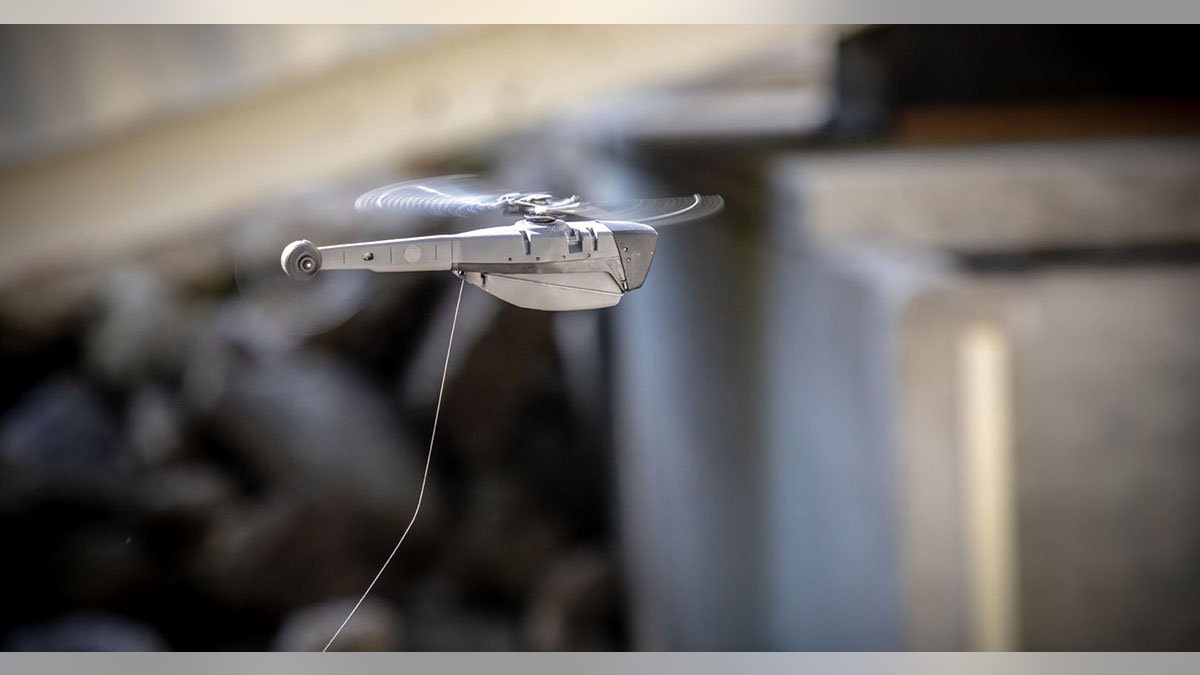
File photo - MARINE CORPS BASE CAMP PENDLETON, Calif. - U.S. Marine Lance Cpl. Cesar Salinas, an infantry Marine with Kilo Company, 3rd Battalion 5th Marine Regiment, displays the PD-100 Black Hornet after an exercise for Marine Corps Warfighting Laboratory's Marine Air-Ground Task Force Integrated Experiment on Camp Pendleton, Calif., July 9, 2016. (U.S. Marine Corps photo by Pfc. Rhita Daniel/Released) (Public Domain)
This personal pocket-sized, stealthy nano-drone equips soldiers with instant access to a powerful eye in the sky.
Black Hornet flies over enemy forces and transmits live video and HD images back to the soldiers. So quiet and tiny, the nano-drone would be extremely difficult for an enemy force to spot. Adversaries would have no idea U.S. soldiers were watching them.
Designed to fly with a rotor-blade, if you didn’t know better you could mistake Black Hornet for a toy helicopter. FLIR describes its drone as “the world’s smallest ISR-platform.”
Black Hornet is so small that it can fit in the palm of a hand. It’s a mere 6.6-inches long and astoundingly, weighs just over an ounce. In spite of being so tiny, it delivers capabilities similar to large drones because its technology is so advanced. Having drone surveillance capabilities literally in hand and always readily available is clearly a big advantage.
U.S. soldiers will be receiving the latest generation of the Black Hornet. This week at Eurosatory in Paris, Black Hornet 3 is being revealed for the first time. The earlier version, Black Hornet 2, is also being shown, integrated with two different combat vehicles: the BAE Systems CV90 infantry fighting vehicle and the Patria AMV armored vehicle.
EUROSATORY 2018: HUGE WHEELED MILITARY ATV SWIMS AND SURPRISES
Among the advances with Black Hornet 3 are new day and night sensors and new software. The new tech is expected to deliver advancements like enhanced picture quality.

(FLIR)
On May 30, the U.S. Army announced that it is acquiring $2.6 million worth of Black. The nano-drones can help enhance security, reduce risk to soldiers and help to save military lives.
Combat-proven, NATO allies such as Great Britain have long been leveraging the tiny drone in war zones and now U.S. troops will use them widely too.
How will it work?
Squads equipped with Black Hornet will find it can provide a number of advantages.
Ultra lightweight, the drone can be carried in a compact kit on a utility belt. Soldiers can use them for missions during the day, but also at night. Both the thermal and daytime imagers deliver live video and snapshots.
FUTURISTIC MINI-SUB COULD BE A VALUABLE WEAPON FOR NAVY SEALS
Within moments, Black Hornet can be launched to provide immediate situational awareness for all sorts of missions.
The drone can travel up to speeds of 14mph. Something so small and light could easily be thrown around by the wind. The design of Black Hornet equips it with about 22 mph wind tolerance. It can even fly in bad weather.
Soldiers familiar with video games will find it just as easy to fly the Black Hornet.
Adversaries may actively deny GPS or a team could need to send the drone into a structure or underground where GPS can be compromised. This drone can still land and launch when GPS is not available.
How could it be useful?
From a remote position, soldiers can launch Black Hornet. At this safe distance of up to about 1.25 miles from a threat, the drone can help them conduct surveillance and reconnaissance. Seeing through the drone’s eyes, soldiers can see and assess threats that are beyond sight.
SOFIC 2018: AMAZING SPECIAL OPERATIONS VEHICLES, WEAPONS AND MORE ON SHOW
Squads could also launch Black Hornet to help them quickly engage targets from far away and at a safer distance from the threat.
IEDs are a frequent and deadly threat for U.S. troops in war zones. Soldiers can launch the nano-drone to search for IEDs that adversaries have hidden. Using the video feeds, soldiers could locate the bombs on the route ahead and take steps to ensure they do not cause harm to U.S. troops and their allies.
Black Hornets could also identify ambushes lying in wait ahead and identify safer routes for the squad. If a team knows what is up ahead, it is possible to travel more quickly.
In urban environments, Black Hornets could fly ahead to reveal what is around the corners of buildings. They could also be launched to fly through windows before an assault, for example. Knowing details like the number of adversaries inside a structure, where they are located and how they are armed can be crucial.
Despite its tiny size, the drone can fly missions 25 minutes long.
PODCAST: GEORGIA COTTON FIELDS TO COMMANDING DANGEROUS MISSIONS
What’s next?
Nano-drones are in high demand by both friendly and unfriendly forces for military surveillance and reconnaissance – the U.S. military is no exception and has been on the hunt for the very best to provide to soldiers.
DRONE SLAYER: POLARIS MRZR ATVS, CHEVY TRUCKS, ARMED WITH NEW ANTI-DRONE WEAPON
In 2016 and 2017, the Army purchased the Black Hornet for testing and evaluation.
The Army will receive the latest generation Black Hornet in this order with deliveries expected this year. Wider rollout within all infantry units may hopefully someday be a possibility.
The Australian and French militaries are expected to begin deploying Black Hornet 3 too.
The Black Hornet may be used in the future for vehicles as well. From MRZRs and tanks through to the iconic howitzers that fire destructive shells, these nano-drones could be launched from the military vehicles for situational awareness and to support targeting.




















